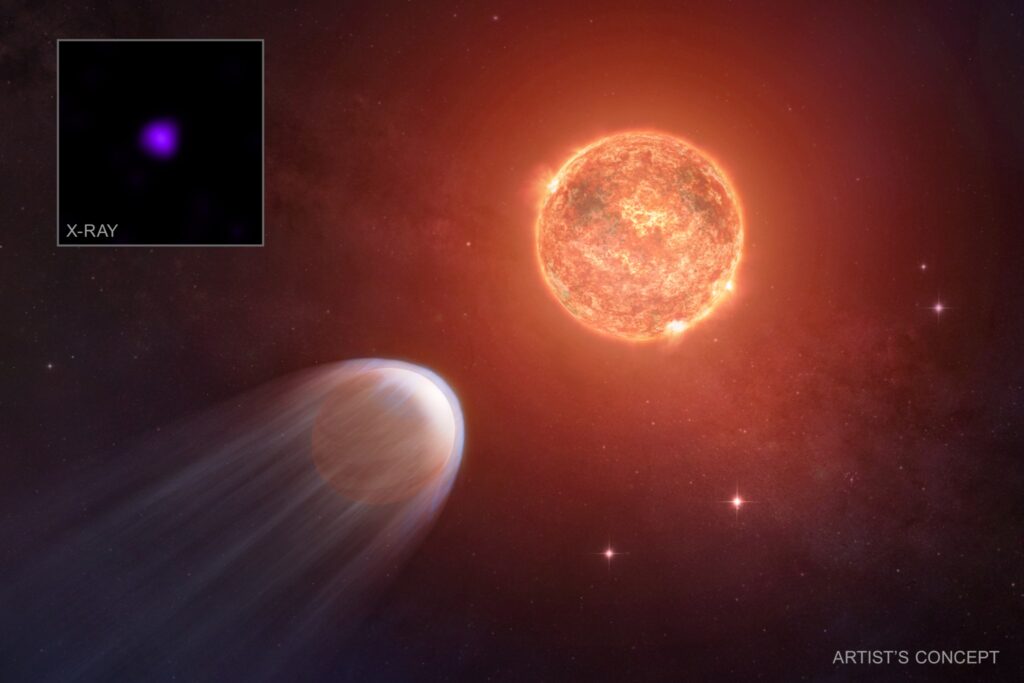
Astronomers have observed a dramatic cosmic phenomenon where a young exoplanet, TOI 1227 b, is rapidly shrinking under the intense bombardment of X-rays from its host star. This discovery, made using data from NASA’s Chandra X-ray Observatory, reveals that the planet is losing its atmosphere at an astonishing rate, transforming from a Jupiter-sized world into a small, barren planet.
The exoplanet, orbiting the star TOI 1227 at a distance much closer than Mercury is to our Sun, is only about 8 million years old. This makes it a thousand times younger than our own Sun. The powerful X-rays emitted by the faint red star are stripping away the planet’s atmosphere, creating a visible blue tail of escaping gases. Researchers estimate that TOI 1227 b is losing a mass equivalent to Earth’s entire atmosphere approximately every 200 years.
Understanding the Phenomenon
The team of researchers, led by Attila Varga from the Rochester Institute of Technology, utilized new data from Chandra to measure the X-ray emissions from TOI 1227. By applying computer models, they determined the transformative effects of these X-rays on the planet’s atmosphere. The study concludes that the exoplanet’s atmosphere may eventually be completely eroded if the current rate of loss continues.
To estimate the age of TOI 1227 b, the researchers employed two methods. The first involved examining how the host star moves through space relative to nearby stars with known ages. The second method compared the star’s brightness and surface temperature with theoretical models of stellar evolution. These analyses confirmed that TOI 1227 b is the second youngest planet observed transiting its host star, with previous estimates suggesting an age of around 11 million years.
Implications for Future Research
TOI 1227 b’s unique characteristics make it an intriguing subject for future studies. Of all known exoplanets younger than 50 million years, it stands out due to its long orbital period and the low mass of its host star. The high levels of X-ray radiation it receives further enhance its appeal as a target for ongoing observation and research.
The findings of this study have been accepted for publication in The Astrophysical Journal. The research team includes experts from various institutions, such as Joel Kastner from the Rochester Institute of Technology, Alexander Binks from the University of Tubingen, Germany, Hans Moritz Guenther from the Massachusetts Institute of Technology, and Simon J. Murphy from the University of New South Wales Canberra in Australia.
Chandra’s Role in Exoplanetary Science
NASA’s Chandra X-ray Observatory continues to play a vital role in the study of exoplanets and their interactions with host stars. Managed by NASA’s Marshall Space Flight Center in Huntsville, Alabama, Chandra’s science operations are conducted by the Smithsonian Astrophysical Observatory’s Chandra X-ray Center in Cambridge, Massachusetts, with flight operations based in Burlington, Massachusetts.
The discovery of TOI 1227 b’s atmospheric loss provides critical insights into the life cycles of young planets and the potential for habitability in extreme environments. As researchers continue to explore these distant worlds, the data from Chandra and other observatories will be essential in expanding our understanding of the universe.
Meanwhile, the broader implications of this research highlight the dynamic and often violent processes that shape planetary systems. As astronomers gather more data, the story of TOI 1227 b and similar exoplanets will undoubtedly contribute to our knowledge of planetary evolution and the conditions that might support life beyond our solar system.






